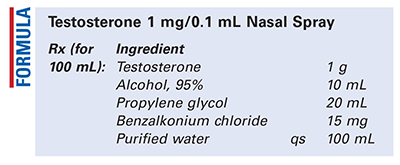US Pharm. 2018;43(8):47-48.

Method of Preparation: Calculate the quantity of each ingredient for the amount to be prepared. Accurately weigh or measure each ingredient. Dissolve the testosterone in the alcohol. Add the propylene glycol and mix well. Add the benzalkonium chloride solution.* Slowly add sufficient purified water to volume and mix well. Package in a calibrated spray container and label.
*Note: A benzalkonium chloride solution may be prepared by diluting 1 mL of benzalkonium chloride 50% solution to 100 mL, resulting in a concentration of 5 mg/mL. Three mL of this dilution may be used for this preparation.
Use: Testosterone nasal spray has been used in bioidentical hormone replacement therapy.
Packaging: Package in calibrated nasal-spray containers.
Labeling: Keep out of reach of children. For nasal use. Discard after ____ [time period].
Stability: A beyond-use date of up to 30 days may be used for this preparation.1
Quality Control: Quality-control assessment can include weight/volume, pH, specific gravity, active drug assay, color, clarity, physical observation, and physical stability (discoloration, foreign materials, gas formation, mold growth).2
Discussion: Testosterone (Androderm, Androgel, Testim, C19H28O2, MW 288.42) occurs as white or slightly creamy white crystals or crystalline powder that is odorless and stable in air. It is practically insoluble in water and soluble 1 g in 5 mL of ethanol. Testosterone melts at between 153°C and 157°C. Testosterone is not very bioavailable when given as an oral-swallow preparation, but it is absorbed when administered buccally and sublingually.3-5
Alcohol (ethyl alcohol, ethanol, grain alcohol, C2H5OH, MW 46.07) is a clear, colorless, mobile, and volatile liquid with a slight, characteristic odor and a burning taste. It is used as an antimicrobial preservative (>10% concentration), disinfectant (60%-90% concentration), solvent in injectable and oral liquids, and solvent in topical products (60%-90% concentration). Its specific gravity is between 0.812 and 0.816, and its boiling point is 78.15°C. Testosterone should be stored in a cool place.6
Propylene glycol (C3H8O2) occurs as a clear, colorless, viscous, practically odorless liquid with a sweet taste. It has a specific gravity of 1.038 g/mL and is miscible with acetone, 95% ethanol, glycerin, and water. Propylene glycol is used as a humectant in topicals (~15% concentration), as a preservative in solutions (15%-30% concentration), and as a solvent or cosolvent in aerosols (10%-30% concentration), oral solutions (10%-25% concentration), parenterals (10%-60% concentration), and topicals (5%-80% concentration).7
Benzalkonium chloride is a bactericidal antimicrobial agent commonly used as a preservative in many ophthalmic, otic, nasal, and parenteral formulations. It occurs as a white or yellowish-white amorphous powder, a thick gel, or gelatinous pieces/flakes with a characteristic mild, aromatic odor, soapy touch, and very bitter taste. Benzalkonium chloride is highly soluble in water, alcohol, and acetone. It is hygroscopic, and a 10% w/v aqueous solution has a pH in the range of 5 to 8. Benzalkonium chloride Solution NF is a clear liquid and is colorless or slightly yellow unless a color has been added. It has an aromatic odor and a bitter taste.8
Purified water is water that is obtained by distillation, ion exchange, reverse osmosis, or some other suitable process. Water has a specific gravity of 0.9971 at room temperature, a melting point of 0°C, and a boiling point of 100°C.9
REFERENCES
1. U.S. Pharmacopeia/National Formulary [current revision]. Rockville, MD: U.S. Pharmacopeial Convention, Inc; July 2018.
2. Allen LV Jr. Standard operating procedure for performing physical quality assessment of oral and topical liquids. IJPC. 1999;3:146-147.
3. McEvoy GK, ed. AHFS Drug Information 2016. Bethesda, MD: American Society of Health-System Pharmacists; 2016:3131-3138.
4. Testosterone. In: Lund W, ed. The Pharmaceutical Codex. 12th ed. London, England: Pharmaceutical Press; 1994:1135-1136.
5. Hardman JG, Limbird LE. Goodman & Gilman’s The Pharmacological Basis of Therapeutics. 10th ed. New York, NY: McGraw-Hill; 2001:1636-1648.
6. Quinn ME. Alcohol. In: Sheskey PJ, Cook WG, Cable CG, eds. Handbook of Pharmaceutical Excipients. 8th ed. London, England: Pharmaceutical Press; 2017:356-359.
7. Driver S. Propylene glycol. In: Sheskey PJ, Cook WG, Cable CG, eds. Handbook of Pharmaceutical Excipients. 8th ed. London, England: Pharmaceutical Press; 2017:795-798.
8. Kibbe AH, Quinn ME. Benzalkonium chloride. In: Sheskey PJ, Cook WG, Cable CG, eds. Handbook of Pharmaceutical Excipients. 8th ed. London, England: Pharmaceutical Press; 2017:99-101.
9. Dubash D, Shah U. Water. In: Rowe RC, Sheskey PJ, Cook WG, Quinn ME, eds. Handbook of Pharmaceutical Excipients. 7th ed. London, England: Pharmaceutical Press; 2012:880-884.
To comment on this article, contact rdavidson@uspharmacist.com.






